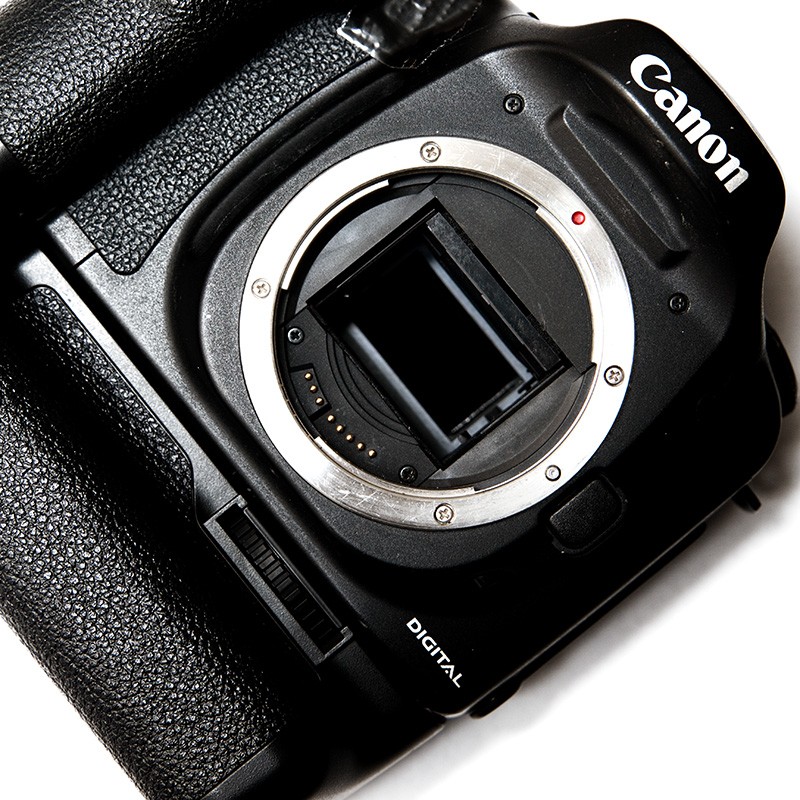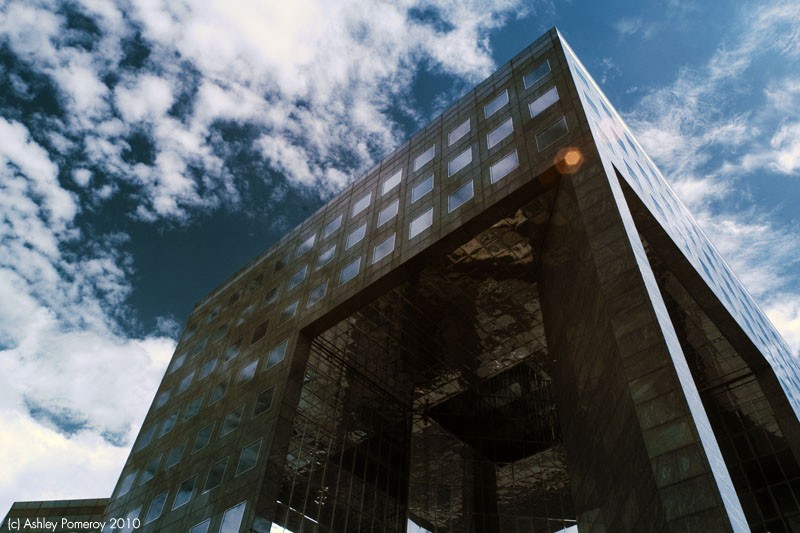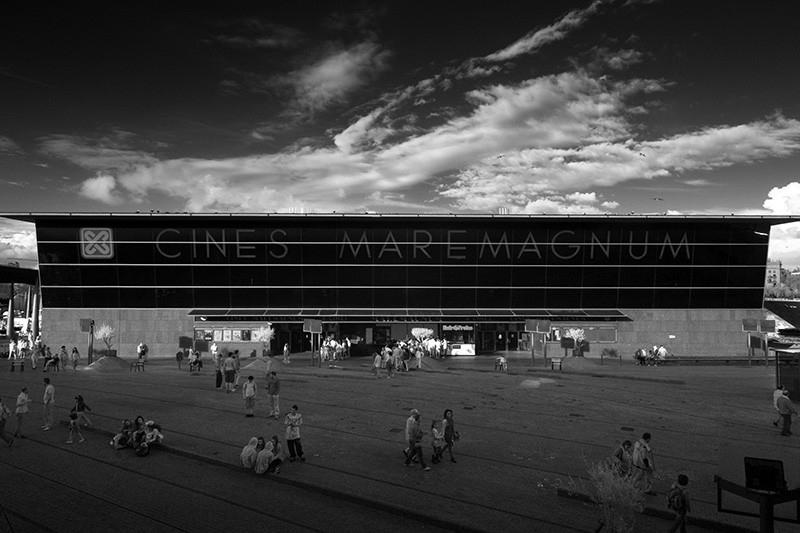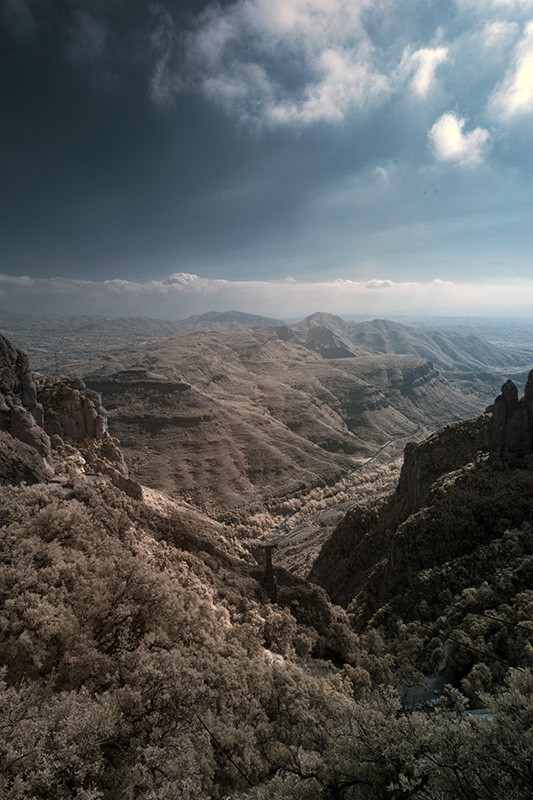
5D MkII / Olympus 24mm f/2 @ f/2
A while back I wrote about the Olympus 24mm f/2.8, a vintage lens for the Olympus OM system of the late twentieth century. Olympus stopped production of the OM range several years ago, but the lenses are still readily available on the used market, and some of them are pretty good. They can be easily adapted to work with modern Canon digital SLRs with a simple metal adapter ring, and unlike some of the old Pentax Takumars they don't have clearance problems with the mirror on a 5D.
The 24mm f/2.8 is particularly handy if you have a 5D, because Canon doesn't sell a good cheap wide angle prime. In fact the company's wide angle range has always been weak; either cheap and nasty, or very expensive and disappointingly okay. The 24mm f/2.8 is nice and sharp and used examples sell for less than £100. It's tiny, too. Tinier than Holly Hunter, who is 5'2". Tinier than Dame Judi Dench, who is 5'09". Tinier even than Christina Ricci, who barely tops five feet. Here's an alpaca:
 I call him McCartney McAlpaca or Macca the Alpaca for short. And he is short; shorter than a llama, which is one of the things that differentiate alpacas and llamas. Alpacas are half the size of llamas. They are shorter than Christina Ricci even, but weigh more than her. This is in contrast to Christina Hendricks, who weighs more than an alpaca but less than a llama. She is taller than an alpaca and almost exactly the same height as a llama. And she has humps, like a camel.
I call him McCartney McAlpaca or Macca the Alpaca for short. And he is short; shorter than a llama, which is one of the things that differentiate alpacas and llamas. Alpacas are half the size of llamas. They are shorter than Christina Ricci even, but weigh more than her. This is in contrast to Christina Hendricks, who weighs more than an alpaca but less than a llama. She is taller than an alpaca and almost exactly the same height as a llama. And she has humps, like a camel.EDIT: A correspondent points out that there appear to be two alpacas rather than just one. This is in fact an illusion; the second alpaca is actually a temporal echo of the first. Alpacas are descended from a race of beings that existed before the physical properties of the universe had become solidified, and are not governed by the laws of time. Thus the second alpaca is actually the first alpaca, but at a different point in the space/time continuum, apparently some time in the past. Alpacas leave a trail of temporal echoes that extend to infinity, but only the first echo is visible; the others have been redshifted by the acceleration of the universe into invisibility, although you can still touch them. It is entirely possible that the alpacas are preceded by an infinite string of blueshifted future alpacas which time is rushing to meet, and that they are the rails upon which time runs, and perhaps they link at some point with the redshifted alpacas to form a giant ring. Like a tiger devouring its own tail.
Still, back on topic. As far as I know it's tricky to mount old OM lenses on other SLR systems. The registration distance is too long for Pentax and Sony / Minolta, and not comfortably long enough for Nikon, although the difference is small enough that the lenses can be modified to work (a company called Leitax will sell you the parts). For the Micro Four Thirds system Olympus will sell you an official adapter, although the 2x crop factor and tiny high-resolution sensor means that the 24mm f/2.8, for example, becomes a mediocre slow 50mm. Then again, if you want a nice sharp 400mm f/4 for a fraction the price of Canon's 400 f/5.6L, there you go. Manual focus, mind.
I think the sculptor started out making a man, and added the breasts later on. Still, the 24mm f/2.8 wasn't Olympus' only 24mm lens. The company tended to make several versions of each focal length, differentiated by lens speed; typically there was a fast, expensive f/2 version and a slower, cheaper f/3.5 budget option and a middle-of-the-road f/2.8. For the 24mm focal length Olympus did things a little bit differently. There were actually two f/2.8s, the manual focus version mentioned above and an autofocus version that came out in 1986, which appears to have had the same optical design. It may well have been just as good, but unfortunately due to some short-sighted thinking by Olympus it was autofocus only, with no manual focus or manual aperture rings. Unless Novoflex ever release an OM-707 - EOS adapter ring it is useless nowadays.
The f/3.5 version, meanwhile, was a stunningly expensive shift lens that sells for nigh-on £1,000 on eBay. Is it any good? I have no idea. You're welcome to buy one and send it to me (seriously - I won't break it) but then again how can you be sure that this blog wasn't started all those years ago for the sole purpose of swindling you out of your Olympus 24mm f/3.5 shift? You can't.
Dah dah dah and there was a fast 24mm, the 24mm f/2. One stop faster than the f/2.8. It's not all that expensive on eBay. Here it is, next to the f/2.8:
 It's relatively massive for an Olympus lens, with a huge 55mm filter thread. It weighs several grams! Mine is presumably multi-coated (it has MC written on it) and has a date code of G18, which means that it was made in August 1981, according to John Hermanson, who is the most useful man on Photo.net. If that one post of the 578 he has posted is the only one of worth, his ratio of useful posts to useless dross is still higher than most of the people on Photo.net.
It's relatively massive for an Olympus lens, with a huge 55mm filter thread. It weighs several grams! Mine is presumably multi-coated (it has MC written on it) and has a date code of G18, which means that it was made in August 1981, according to John Hermanson, who is the most useful man on Photo.net. If that one post of the 578 he has posted is the only one of worth, his ratio of useful posts to useless dross is still higher than most of the people on Photo.net. How much did it cost in 1981? Again, I have no idea. Back in futuristic black-clad 1985 it sold for $203 in the US, according to this B&H price list, which is hosted by a man called Nesster, who has a tonne of fascinating old magazine ads and things. The same page also lists the old, FD version of the Canon 24mm f/1.4 L, which was $584. Why $584? Why not $599? You'd think, being American, the people of B&H would not be wonky with money.
How much did it cost in 1981? Again, I have no idea. Back in futuristic black-clad 1985 it sold for $203 in the US, according to this B&H price list, which is hosted by a man called Nesster, who has a tonne of fascinating old magazine ads and things. The same page also lists the old, FD version of the Canon 24mm f/1.4 L, which was $584. Why $584? Why not $599? You'd think, being American, the people of B&H would not be wonky with money. Nikon and Canon also made 24mm f/2 lenses, and so did plucky little Pentax! The dears. None of them seem to have captured anybody's imagination, certainly not compared to the Nikon 28mm f/2.0 or the Canon 24mm f/1.4 or the Zeiss 20mm Flektogon etc etc. Perhaps the spec fell between too many stools; 24mm isn't super-wide and f/2 isn't super-fast. Even on a full-frame body you need to put the subject right up close to the camera to get narrow depth-of-field effects, and if you're using a modern digital SLR and the light is getting low you can just turn up the ISO value. Nowadays if you want a fast 24mm you have a choice between Nikon and Canon's 24mm f/1.4, which are exotic and expensive, and that's about it. If you want a fast prime with a 24mm focal length for an APS-C digital SLR you're out of luck, because there aren't any. Yet. Is there a market for an APS-C 16mm f/1.4? Sigma, are you listening?
Nikon and Canon also made 24mm f/2 lenses, and so did plucky little Pentax! The dears. None of them seem to have captured anybody's imagination, certainly not compared to the Nikon 28mm f/2.0 or the Canon 24mm f/1.4 or the Zeiss 20mm Flektogon etc etc. Perhaps the spec fell between too many stools; 24mm isn't super-wide and f/2 isn't super-fast. Even on a full-frame body you need to put the subject right up close to the camera to get narrow depth-of-field effects, and if you're using a modern digital SLR and the light is getting low you can just turn up the ISO value. Nowadays if you want a fast 24mm you have a choice between Nikon and Canon's 24mm f/1.4, which are exotic and expensive, and that's about it. If you want a fast prime with a 24mm focal length for an APS-C digital SLR you're out of luck, because there aren't any. Yet. Is there a market for an APS-C 16mm f/1.4? Sigma, are you listening?But anyway, let's have a look at the Olympus 24mm f/2. What's it like? How does it compare with the 24mm f/2.8? And will Heironymus Merkin ever forget Mercy Humppe and find true happiness?
Here's what the vignetting looks like at f/2, shot on a 5D MkII with live view:
 Here's the middle at f/2. A 100% crop uncorrected for anything, but with mild unsharp mask of 0, 0.5, 150. It's generally sharp but has a kind of purple glow which, to be fair, wouldn't be so visible if there was less snow:
Here's the middle at f/2. A 100% crop uncorrected for anything, but with mild unsharp mask of 0, 0.5, 150. It's generally sharp but has a kind of purple glow which, to be fair, wouldn't be so visible if there was less snow: Here's part of the right edge, just outside the APS-C zone:
Here's part of the right edge, just outside the APS-C zone: On an APS-C camera, such as a 60D, it would be a kind of 38mm f/3 t/2 e.g. it would transmit as much light as an f/2 lens but with the apparent depth of field of something like an f/3 lens in full-frame terms. And here's the bottom-right corner, which is softer. Serves you right for shooting a landscape at f/2:
On an APS-C camera, such as a 60D, it would be a kind of 38mm f/3 t/2 e.g. it would transmit as much light as an f/2 lens but with the apparent depth of field of something like an f/3 lens in full-frame terms. And here's the bottom-right corner, which is softer. Serves you right for shooting a landscape at f/2: Before we go on, here's something else. This was also shot at f/2 and illustrates something called coma, which goes away when you stop down. At f/2 it distorts point light sources and creates an odd swirly effect:
Before we go on, here's something else. This was also shot at f/2 and illustrates something called coma, which goes away when you stop down. At f/2 it distorts point light sources and creates an odd swirly effect: Here's a phone box. The exact same box appears at the bottom of this post, but in daylight and a day later, after England was destroyed by snow:
Here's a phone box. The exact same box appears at the bottom of this post, but in daylight and a day later, after England was destroyed by snow: Let's introduce the 24mm f/2.8. Here's the middle at f/2.8 - one stop down for the f/2 - with the f/2 at the top and the f/2.8 at the bottom:
Let's introduce the 24mm f/2.8. Here's the middle at f/2.8 - one stop down for the f/2 - with the f/2 at the top and the f/2.8 at the bottom: I was curious to see if the 24mm f/2 was better than the 24mm f/2.8 at f/2.8, and by gum it appears to be so. Not by much, but it's there; more contrast, less glow, a bit sharper.
I was curious to see if the 24mm f/2 was better than the 24mm f/2.8 at f/2.8, and by gum it appears to be so. Not by much, but it's there; more contrast, less glow, a bit sharper.Here's the just-past APS-C edge at f/2.8, f/2 at the top. They look pretty much the same:
 And here's the corner. "Master Ninja Theme Song!":
And here's the corner. "Master Ninja Theme Song!": That'll also teach you to shoot landscapes at f/2.8. The 24mm f/2.8 actually looks a bit better in the extreme corner. How about f/11? Eh? How about it?
That'll also teach you to shoot landscapes at f/2.8. The 24mm f/2.8 actually looks a bit better in the extreme corner. How about f/11? Eh? How about it? I'm fairly sure the f/2 is at the top. If I layer one image on top of the other and then switch between them I can't see any difference that can't be explained by minor variations of exposure and colour temperature. The Canon body, left to its own devices, shot slightly blue through the f/2, slightly green through the f/2.8. Here's the edge, and notice the CA:
I'm fairly sure the f/2 is at the top. If I layer one image on top of the other and then switch between them I can't see any difference that can't be explained by minor variations of exposure and colour temperature. The Canon body, left to its own devices, shot slightly blue through the f/2, slightly green through the f/2.8. Here's the edge, and notice the CA: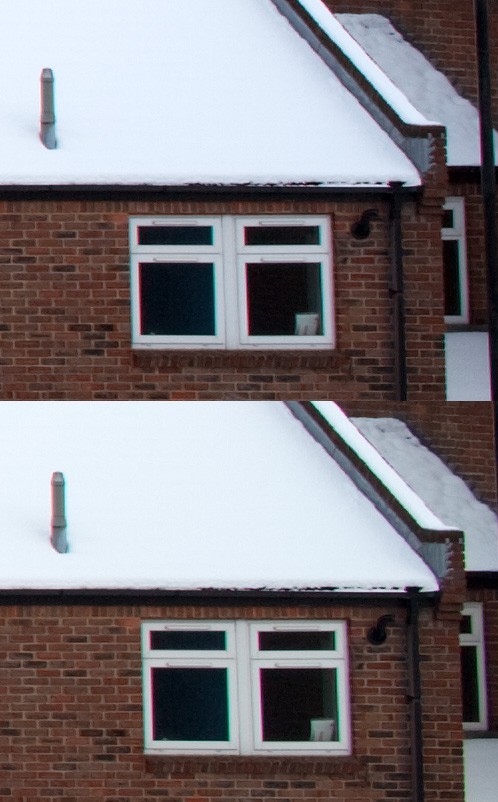 The difference is striking...ly absent. Here's the corner:
The difference is striking...ly absent. Here's the corner: The f/2 is just slightly better to my eye. Just slightly fuzzy in the last few pixels. As before these are 100% crops from a 21mp full-frame image.
The f/2 is just slightly better to my eye. Just slightly fuzzy in the last few pixels. As before these are 100% crops from a 21mp full-frame image.I was curious to see how it would be with video, so here are some shots at f/2 with some music by myself layered over the top:
The music is basically the same tune as the second half of this, but faster, and the bass seems to have survived Youtube's uploading process. I arranged it with Audiomulch, and made the robot voice-type effect by feeding the drums and the bassline into a vocoder. In retrospect I needed a graduated neutral density filter to dim the sky a bit. f/2 is handy for low-light, but as mentioned earlier it's hard to get sweet depth-of-field effects at 24mm. So, if you're shooting video, it's not much more useful than any other 24mm prime, or indeed a 24mm zoom, albeit that the 24mm f/2 will probably have less distortion, which is harder to correct with video (if only because a lot of editors don't have distortion correction options; Virtualdub will do it, but it's not a simple click-and-drag operation).
Internet legend has it that the f/2 suffers from a kind of hard-to-correct moustache waveform distortion, but it doesn't really leap out at me. It exists, though, as in the following photograph taken at Sidi Bou Said in Tunisia that has the horizon along the top:
 At the top f/2, illustrating the vignetting, below it f/8. At this distance essentially everything is in focus at f/2; I would have needed to get real close to the post to blur out the background. Why didn't I? Can't remember. From top to bottom it says BOCH 8Y, RANOU, ANGFAROUHAI, CHACHA, CHACHO, ZIZOU, HOS, S, A.
At the top f/2, illustrating the vignetting, below it f/8. At this distance essentially everything is in focus at f/2; I would have needed to get real close to the post to blur out the background. Why didn't I? Can't remember. From top to bottom it says BOCH 8Y, RANOU, ANGFAROUHAI, CHACHA, CHACHO, ZIZOU, HOS, S, A. Still, and in conclusion, the Olympus 24mm f/2 is sweet. Stopped down it's extremely good; at f/2 it's not fantastic, but at least you have f/2. And despite being larger than most Olympus wide angle primes it's still relatively compact. Here's that phone box again:
Still, and in conclusion, the Olympus 24mm f/2 is sweet. Stopped down it's extremely good; at f/2 it's not fantastic, but at least you have f/2. And despite being larger than most Olympus wide angle primes it's still relatively compact. Here's that phone box again: All of the flavour shots in this post were taken at f/2; the vignetting actually helps this image because it makes the phone box stand out. Here's a 100% crop of the middle to illustrate what f/2 in the middle looks like in a real-world shot:
All of the flavour shots in this post were taken at f/2; the vignetting actually helps this image because it makes the phone box stand out. Here's a 100% crop of the middle to illustrate what f/2 in the middle looks like in a real-world shot: Here's some flare, shot at ISO 3200. The flare isn't the white blob to the left - that's the moon, suffering from the coma I mentioned previously - it's the patch just right of centre:
Here's some flare, shot at ISO 3200. The flare isn't the white blob to the left - that's the moon, suffering from the coma I mentioned previously - it's the patch just right of centre: And this is the end of the post. Scroll down a bit for almost exactly the same shot, but in infrared! With a 10D struggling at 1600.
And this is the end of the post. Scroll down a bit for almost exactly the same shot, but in infrared! With a 10D struggling at 1600.



















